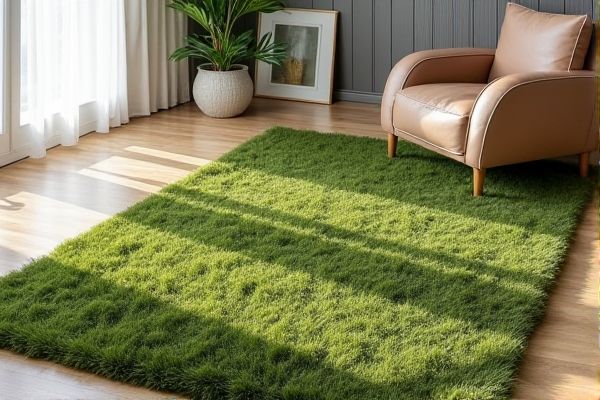
Faux grass rugs offer realistic texture and vibrant green color, making them ideal for decorative indoor or outdoor spaces, while fiber mats provide more durability and moisture absorption, perfect for high-traffic or entryway use. Discover which option best suits your lifestyle and space needs by reading the rest of this article.
Table of Comparison
| Feature | Faux Grass Rug | Fiber Mat |
|---|---|---|
| Material | Synthetic grass fibers (polyethylene, polypropylene) | Natural or synthetic fibers (coir, jute, nylon) |
| Appearance | Grass-like, green textured surface | Coarse or woven textured surface |
| Durability | High, weather-resistant | Moderate, may degrade with moisture |
| Maintenance | Easy, hose down or vacuum | Requires regular cleaning, sensitive to water |
| Indoor/Outdoor Use | Suitable for both indoor and outdoor | Primarily indoor or sheltered outdoor areas |
| Comfort | Soft, cushioned feel | Firm, coarse texture |
| Price | Moderate to high | Low to moderate |
Introduction to Faux Grass Rugs vs. Fiber Mats
Faux grass rugs mimic the natural look and feel of real grass, offering durability and easy maintenance ideal for indoor and outdoor spaces. Fiber mats, typically made from coir, jute, or synthetic fibers, provide a more traditional texture with excellent water resistance and anti-slip properties. Choosing between a faux grass rug and a fiber mat depends on your desired aesthetic, durability needs, and placement environment.
Material Composition: Synthetic vs. Natural Fibers
Faux grass rugs are made from synthetic materials like polyethylene or polypropylene, offering durability and resistance to moisture and UV rays, making them ideal for both indoor and outdoor use. Fiber mats typically use natural fibers such as coir, jute, or sisal, providing a biodegradable option that adds a rustic texture but may require more care to avoid wear and mold. Choosing between these depends on your preference for low-maintenance synthetic durability or the eco-friendly, organic feel of natural fibers.
Aesthetic Appeal and Realism
Faux grass rugs offer a highly realistic texture and vibrant green hues that closely mimic natural grass, making them ideal for enhancing outdoor and indoor spaces with a fresh, natural look. Fiber mats, typically made from coir, jute, or synthetic fibers, provide a rustic and earthy aesthetic but lack the smooth, lush appearance of faux grass. The synthetic blades of faux grass rugs create a more consistent and visually appealing surface, offering superior realism compared to the coarse, uneven texture of fiber mats.
Comfort and Texture Underfoot
Faux grass rugs provide a soft, natural feel underfoot, mimicking real grass with a cushioned texture that enhances comfort. Fiber mats, often made from coir or synthetic fibers, offer firmer support and a rougher surface that is durable but less plush compared to faux grass. Your choice depends on whether you prioritize a more natural, cushy sensation or a robust, textured foundation for your space.
Durability and Longevity
Faux grass rugs offer superior durability and longevity compared to fiber mats due to their UV-resistant synthetic fibers that withstand heavy foot traffic and outdoor elements without fading or breaking down. Fiber mats, often made from natural materials like coir or jute, tend to degrade faster when exposed to moisture and frequent wear, making them less suitable for high-traffic or outdoor areas. Investing in a high-quality faux grass rug ensures extended lifespan and consistent performance in diverse environmental conditions.
Maintenance and Cleaning Requirements
Faux grass rugs require minimal maintenance, needing only occasional brushing and hosing down to remove dirt and debris without fading or mold risks. Fiber mats, typically made from natural materials like coir or sisal, demand regular vacuuming and spot cleaning to prevent fiber breakdown and retain appearance. Both options offer durable outdoor solutions, but faux grass rugs provide easier upkeep with superior resistance to moisture and staining.
Environmental Impact and Sustainability
Faux grass rugs, typically made from synthetic materials like polyethylene, have a lower biodegradability rate compared to natural fiber mats, which are usually crafted from renewable resources such as jute or coir. Natural fiber mats decompose more quickly, reducing landfill waste and contributing to a smaller environmental footprint, while faux grass rugs may release microplastics during wear and disposal. Choosing Your floor covering with sustainability in mind means considering the lifecycle and material origin, where fiber mats often present a more eco-friendly option.
Safety Considerations and Allergen Concerns
Faux grass rugs are typically made from synthetic materials like polyethylene or polypropylene, which are durable and resistant to mold but may emit VOCs affecting indoor air quality. Fiber mats, often composed of natural fibers such as coir or jute, present lower chemical risks but can harbor dust mites and allergens if not regularly cleaned. To protect Your health, choose hypoallergenic materials and maintain cleanliness to minimize safety and allergen concerns in both options.
Cost Comparison and Value for Money
Faux grass rugs typically cost more upfront than fiber mats but offer greater durability and a realistic outdoor look, enhancing long-term value for money. Fiber mats are budget-friendly and suitable for temporary use but may wear out faster and require frequent replacement. Investing in a faux grass rug offers better resilience and aesthetic appeal, making it a cost-effective choice for your home or garden.
Best Uses: Ideal Settings for Each Option
Faux grass rugs are perfect for creating a natural, vibrant look in outdoor patios, balconies, or indoor sunrooms, offering a soft, low-maintenance surface that mimics real grass. Fiber mats excel in high-traffic entryways and mudrooms, providing durability and excellent dirt-trapping capabilities to keep your floors clean. Your choice depends on the setting's traffic level, desired aesthetic, and maintenance needs.
 homyna.com
homyna.com